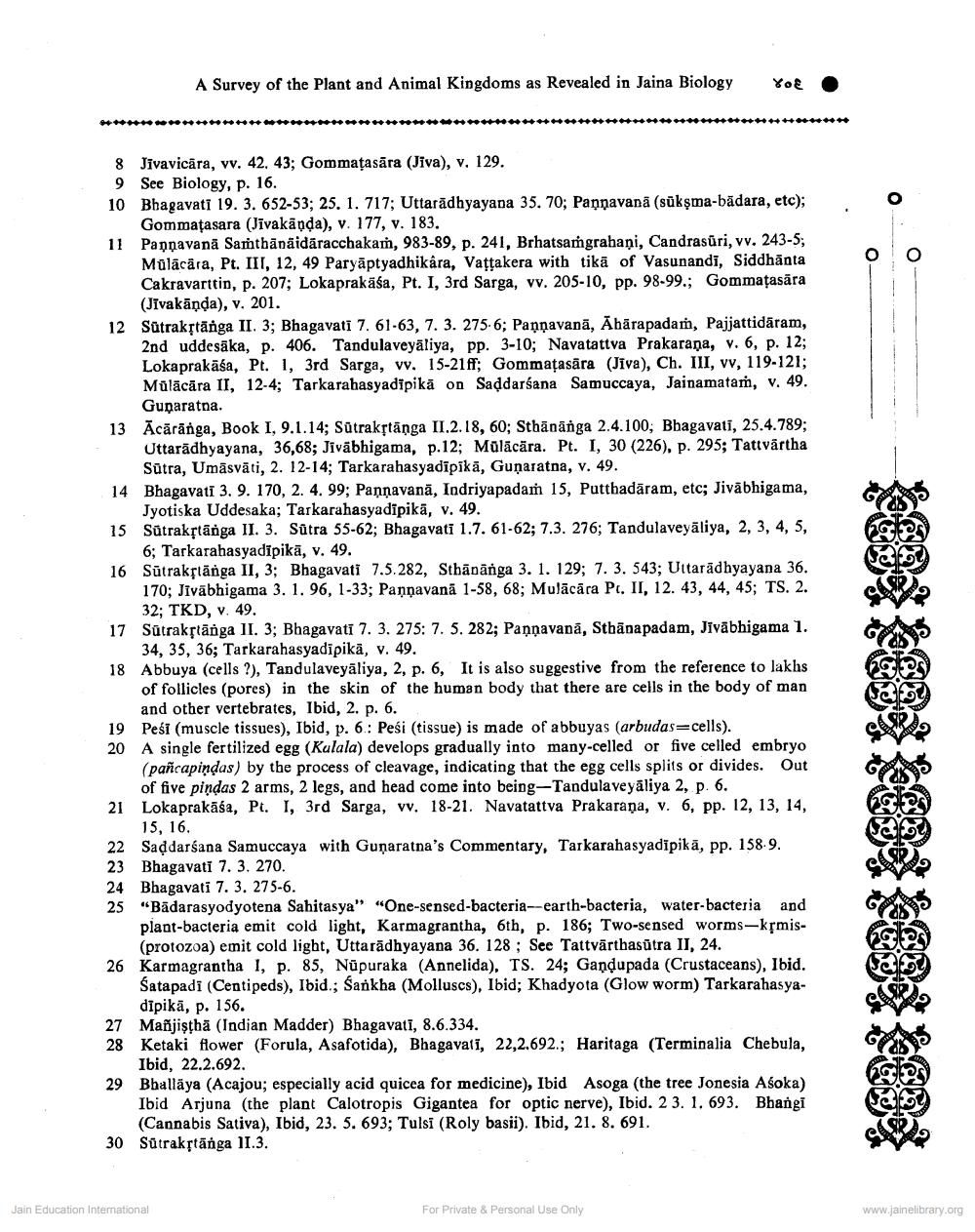________________
A Survey of the plant and Animal Kingdoms as Revealed in Jaina Biology
Boa
8 Jivavicära, v. 42, 43; Gommațasāra (Jiva), v. 129. 9 See Biology, p. 16. 10 Bhagavati 19. 3. 652-53; 25. 1. 717; Uttarādhyayana 35. 70; Pannavanā (sükşma-bādara, etc);
Gommatasara (Jivakanda), v. 177, v. 183. 11 Pannavanā Samtbänäidaracchakam, 983-89, p. 241, Brhatsagrahani, Candrasuri, vv. 243-5;
Mulācära, Pt. III, 12, 49 Paryāptyadhikara, Vattakera with tikā of Vasunandi, Siddhānta Cakravarttin, p. 207; Lokaprakāśa, Pt. I, 3rd Sarga, vv. 205-10, pp. 98-99.; Gommațasāra
(Jivakāņda), v. 201. 12 Sūtrakstānga II. 3; Bhagavati 7. 61-63, 7. 3. 275-6; Pannavanā, Āhārapadam, Pajjattidaram,
2nd uddesāka, p. 406. Tandulaveyāliya, pp. 3-10; Navatattva Prakarana, v. 6, p. 12; Lokaprakāśa, Pt. 1, 3rd Sarga, vv. 15-21ff; Gommațasāra (Jiva), Ch. III, vv, 119-121; Mulācāra II, 12-4; Tarkarahasyadipikä on Saddarśana Samuccaya, Jainamatam, v. 49.
Gunaratna. 13 Ācārānga, Book I, 9.1.14; Sätrakstānga II.2.18, 60; Sthänänga 2.4.100, Bhagavati, 25.4.789;
Uttarādhyayana, 36,68; Jiväbhigama, p.12; Mülācāra. Pt. I, 30 (226), p. 295; Tattvärtha
Sutra, Umāsvāti, 2. 12-14; Tarkarahasyadipikā, Gunaratna, v. 49. 14 Bhagavati 3. 9. 170, 2. 4. 99; Pannavanā, Indriyapadam 15, Putthadāram, etc; Jivābhigama,
Jyotiska Uddesaka; Tarkarahasyadipikā, v. 49. 15 Sūtrakstānga II. 3. Sutra 55-62; Bhagavati 1.7. 61-62; 7.3. 276; Tandulaveyaliya, 2, 3, 4, 5,
6; Tarkarahasyadipikā, v. 49. 16 Sūtrakstānga II, 3; Bhagavati 7.5.282, Sthāpānga 3. 1. 129; 7. 3. 543; Uttaradhyayana 36.
170; Jivābhigama 3. 1. 96, 1-33; Paņņavanā 1-58, 68; Mulācāra P. II, 12. 43, 44, 45; TS. 2.
32; TKD, V. 49. 17 Sūtrakstānga II. 3; Bhagavati 7. 3. 275: 7. 5. 282; Pannavanā, Sthānapadam, Jivābhigama 1.
34, 35, 36; Tarkarahasyadipika, v. 49. 18 Abbuya (cells ?), Tandulaveyaliya, 2, p. 6, It is also suggestive from the reference to lakhs
of follicles (pores) in the skin of the human body that there are cells in the body of man
and other vertebrates, Ibid, 2. p. 6. 19 Peši (muscle tissues), Ibid, p. 6: Pesi (tissue) is made of abbuyas (arbudas=cells). 20 A single fertilized egg (Kulala) develops gradually into many-celled or five celled embryo
(pañcapindas) by the process of cleavage, indicating that the egg cells splits or divides. Out
of five pindas 2 arms, 2 legs, and head come into being-Tandulaveyāliya 2, p. 6. 21 Lokaprakāśa, Pt. I, 3rd Sarga, vv. 18-21. Navatattva Prakaraņa, v. 6, pp. 12, 13, 14,
15, 16.
Saddarśana Samuccaya with Gunaratna's Commentary, Tarkarahasyadipikā, pp. 158.9. 23 Bhagavati 7. 3. 270. 24 Bhagavati 7. 3. 275-6. 25 "Bādarasyodyotena Sahitasya" "One-sensed-bacteria--earth-bacteria, water-bacteria and
plant-bacteria emit cold light, Karmagrantha, 6th, p. 186; Two-sensed worms-krmis
(protozoa) emit cold light, Uttarādhyayana 36. 128 ; See Tattvärthasūtra II, 24. 26 Karmagrantha I, p. 85, Nüpuraka (Annelida), TS. 24; Gandupada (Crustaceans), Ibid.
Satapadi (Centipeds), Ibid.; Sankha (Molluscs), Ibid; Khadyota (Glow worm) Tarkarahasya
dīpikā, p. 156. 27 Mañjiştha (Indian Madder) Bhagavati, 8.6.334. 28 Ketaki flower (Forula, Asafotida), Bhagavatī, 22,2.692.; Haritaga (Terminalia Chebula,
Ibid, 22.2.692. 29 Bhallaya (Acajou; especially acid quicea for medicine), Ibid Asoga (the tree Jonesia Asoka)
Ibid Arjuna (the plant Calotropis Gigantea for optic nerve), Ibid. 2 3. 1. 693. Bhangi
(Cannabis Sativa), Ibid, 23. 5. 693; Tulsi (Roly basii). Ibid, 21. 8. 691. 30 Sūtrakstānga 11.3.
Jain Education International
For Private & Personal Use Only
www.jainelibrary.org




